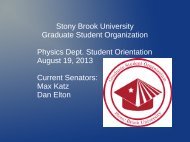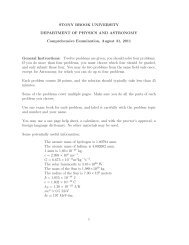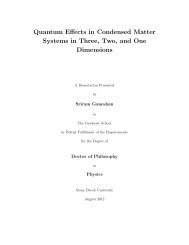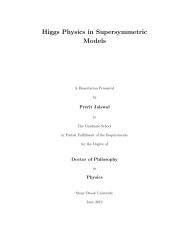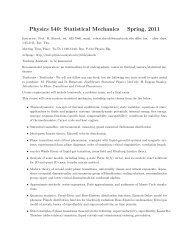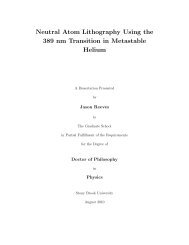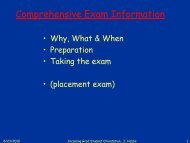Theory of Nuclear Matter for Neutron Stars and ... - Graduate Physics
Theory of Nuclear Matter for Neutron Stars and ... - Graduate Physics
Theory of Nuclear Matter for Neutron Stars and ... - Graduate Physics
Create successful ePaper yourself
Turn your PDF publications into a flip-book with our unique Google optimized e-Paper software.
141210Phase diagram, Y p =0.45SLy4FRTF ModifiedFRTF TruncatedT (MeV)864201e-06 1e-05 0.0001 0.001 0.01 0.1 1ρ (fm -3 )Figure 6.9: This figure shows the phase boundaries <strong>of</strong> dense matter when Y p = 0.45.6.7 ConclusionsThe liquid droplet approach is the most promising method to generate thermodynamicallyconsistent nuclear EOS table. The nuclear <strong>for</strong>ce model should be tested be<strong>for</strong>e making anEOS table so that the table represents both nuclear experiments on Earth <strong>and</strong> astrophysicalobservations.To make the EOS consistent with the nuclear physics aspect, we have to use one nuclear<strong>for</strong>ce model to calculate the energy contribution from heavy nuclei, nucleons outside, <strong>and</strong>surface tension. In the thermodynamical sense, the derivatives in liquid droplet approachare written analytically <strong>and</strong> can be compared with numerical derivatives.We treat electrons <strong>and</strong> photons separately since they interact weakly. But we add themto calculate total energy, pressure, entropy <strong>and</strong> their derivative with respect to temperature,density, <strong>and</strong> proton composition.For finite temperature, we have to calculate the Fermi integral (F 1/2 , F 3/2 ) to obtain numberdensity <strong>and</strong> momentum density. The interpolation from the table cannot give enough accuracyat low temperature (T ≤ 1 MeV). JEL is a successful scheme to give enough accuracy<strong>for</strong> all domains (relativistic vs. non-relativistic, degenerate <strong>and</strong> non-degenerate).Phase transitions around half <strong>of</strong> nuclear saturation density (1/2ρ 0 ) can be achieved when weemploy the geometric function D <strong>and</strong> changing the dimension d continuously.We should be able to combine the liquid droplet approach with a relativistic mean fieldmodel in the near future if we h<strong>and</strong>le the large L with acceptable values so new parameters102



